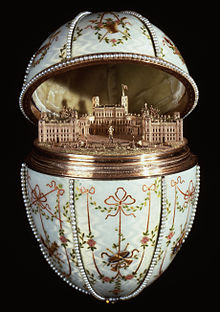
In art history, the French term objet d'art (/ˌɒbʒeɪ ˈdɑːr/ ; French pronunciation: [ɔbʒɛ daʁ]) describes an ornamental work of art, and the term objets d’art describes a range of works of art, usually small and three-dimensional, made of high-quality materials, and a finely-rendered finish that emphasises the aesthetics of the artefact.[1] Artists create and produce objets d’art in the fields of the decorative arts and metalwork, porcelain and vitreous enamel; figurines, plaquettes, and engraved gems; ivory carvings and semi-precious hardstone carvings; tapestries, antiques, and antiquities; and books with fine bookbinding.
The National Maritime Museum, Greenwich, London, describes their accumulated artworks as a: "collection of objets d’art [which] comprises over 800 objects. These are mostly small, decorative art items that fall outside the scope of the Museum’s ceramic, plate, textiles and glass collections." The artwork collection also includes metal curtain ties, a lacquered papier-maché tray, tobacco boxes, cigarette cases, découpage (cut-paper items), portrait miniatures, a gilt-brass clock finial, plaques, statuettes, plaquettes, a horse brass, a metal pipe tamper, a small glass painting, et cetera.[2]
- ^ The New Shorter Oxford English Dictionary (1993) Lesley Brown, Ed. p. 1,965.
- ^ objets d'art Archived 2012-09-04 at the Wayback Machine, National Maritime Museum
